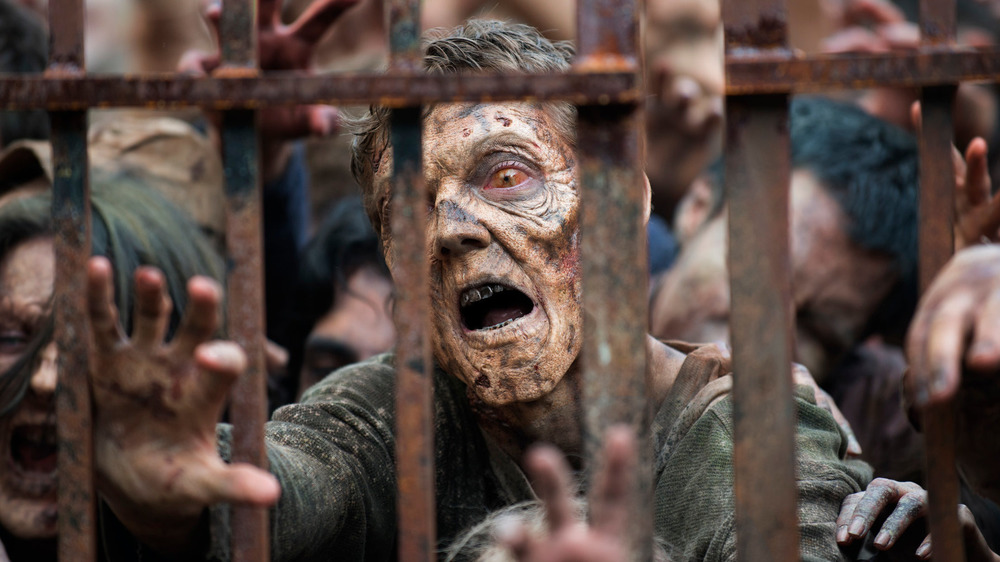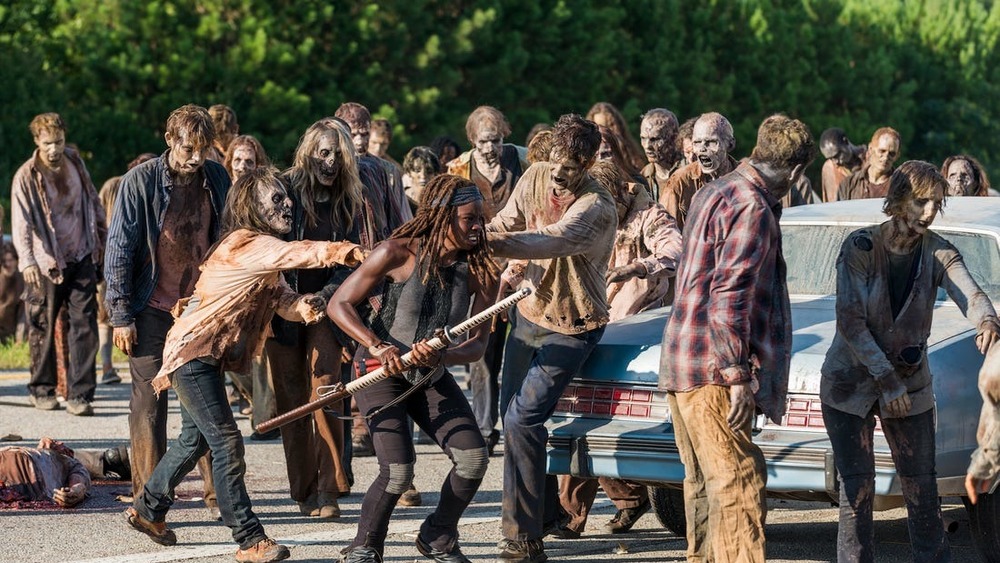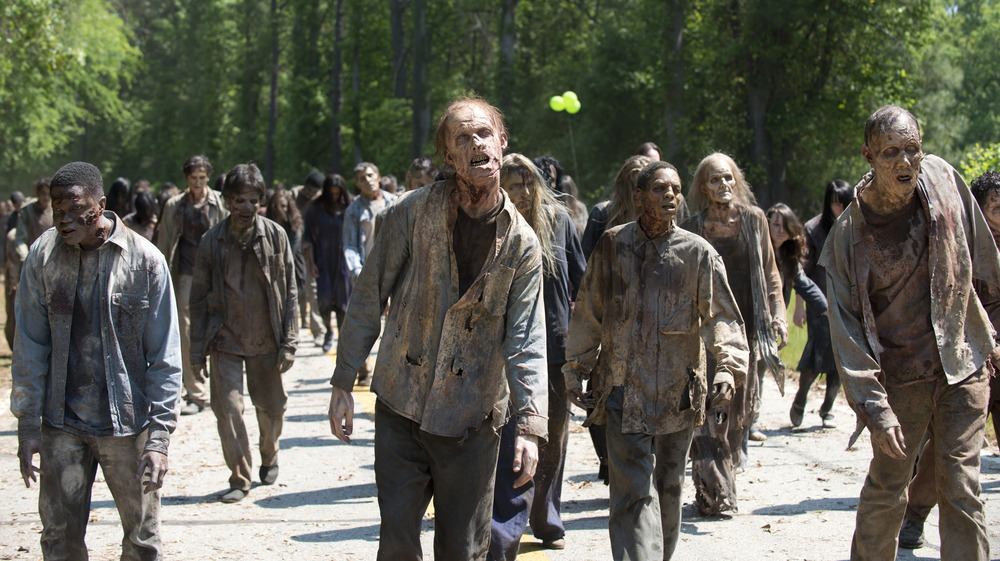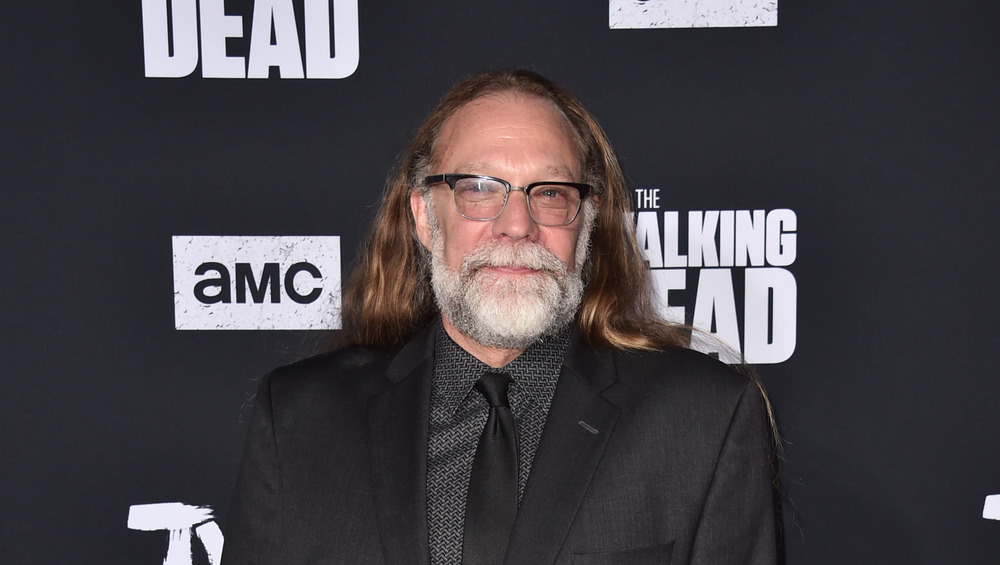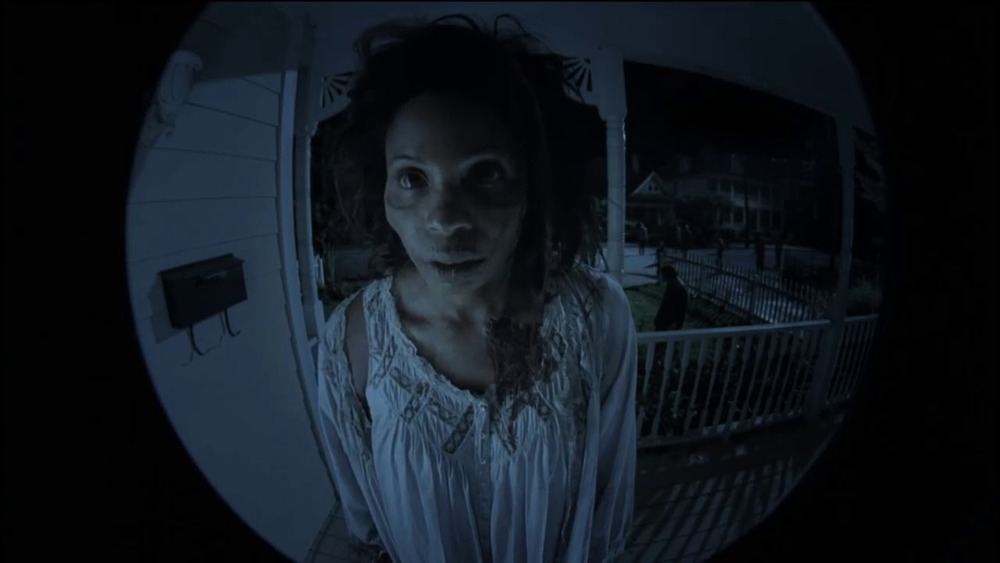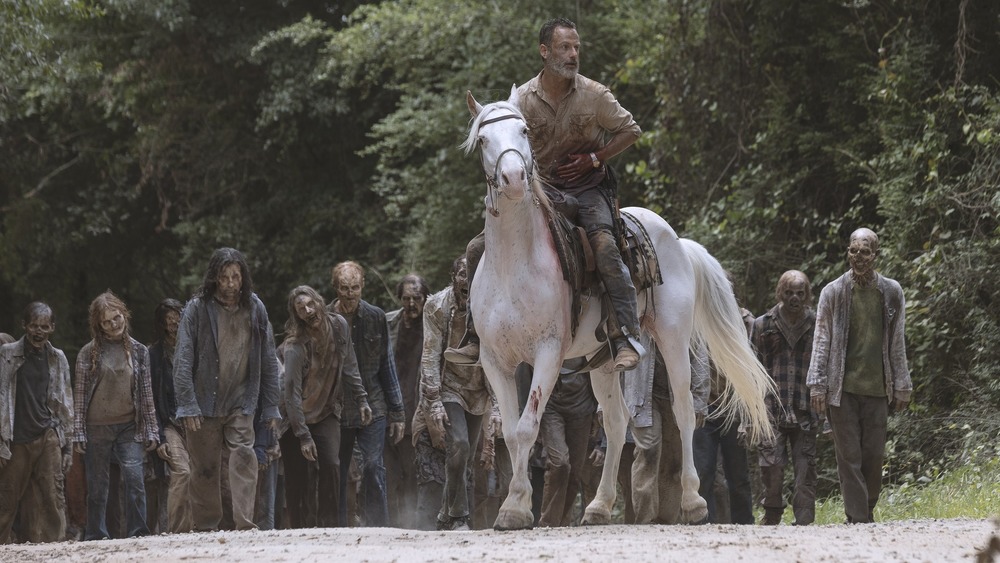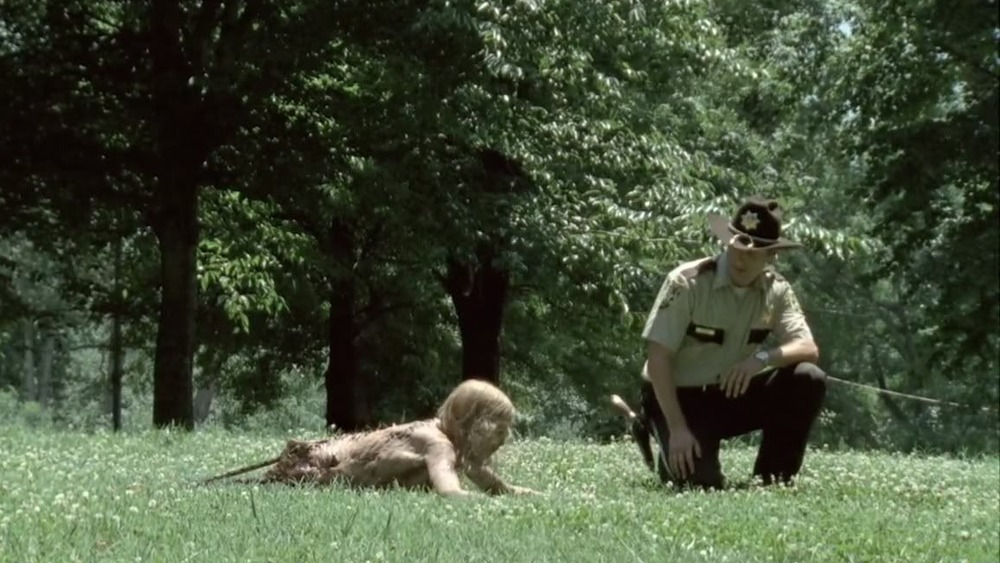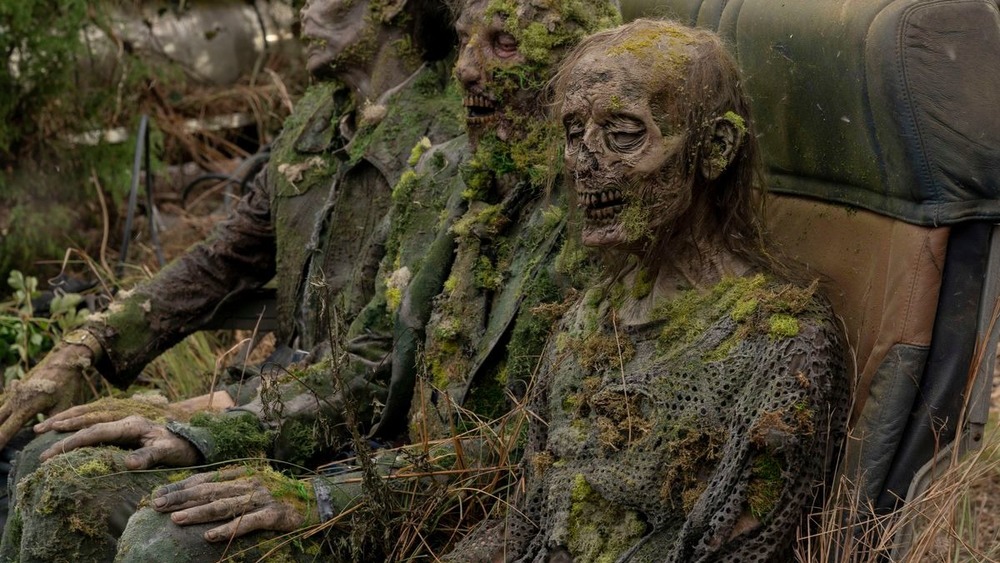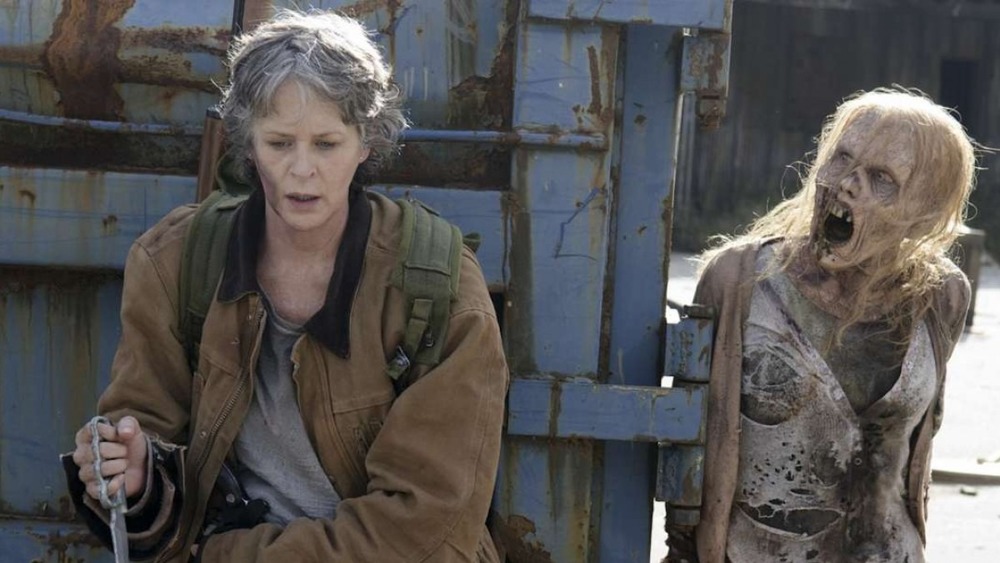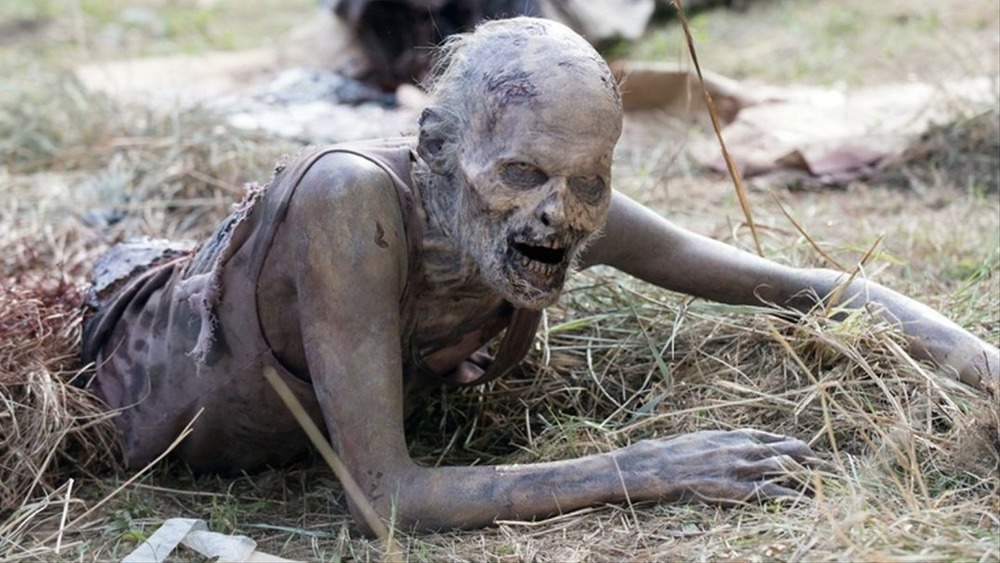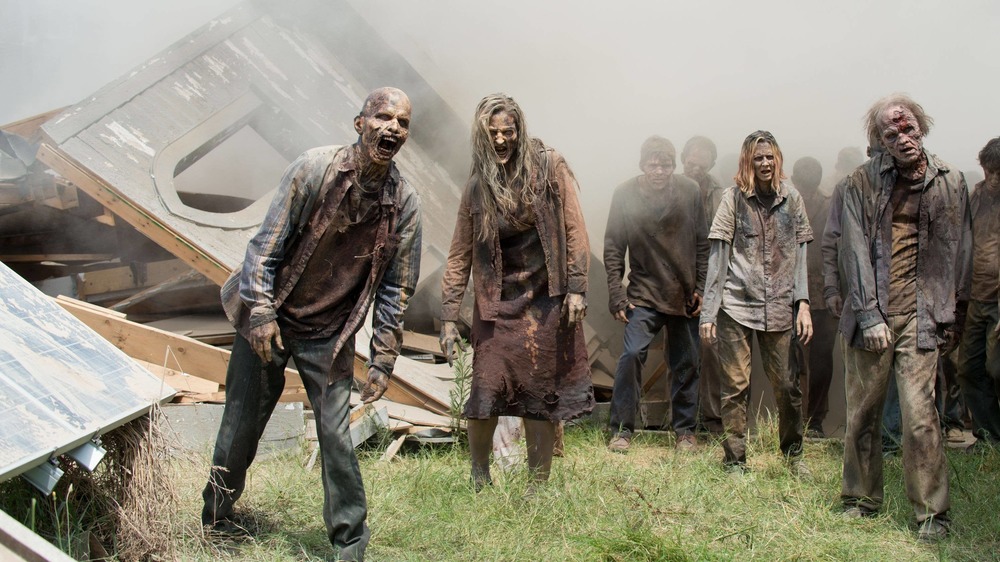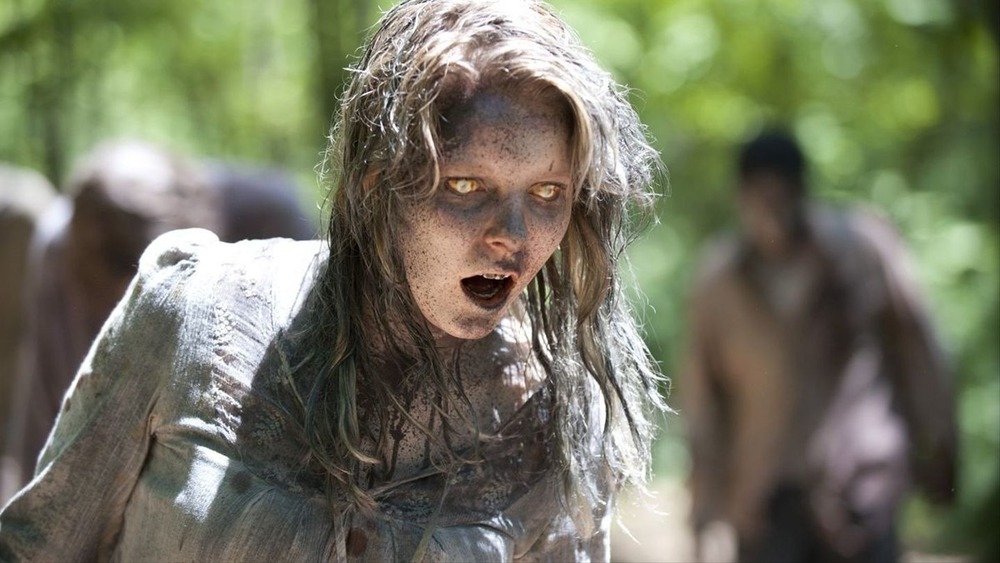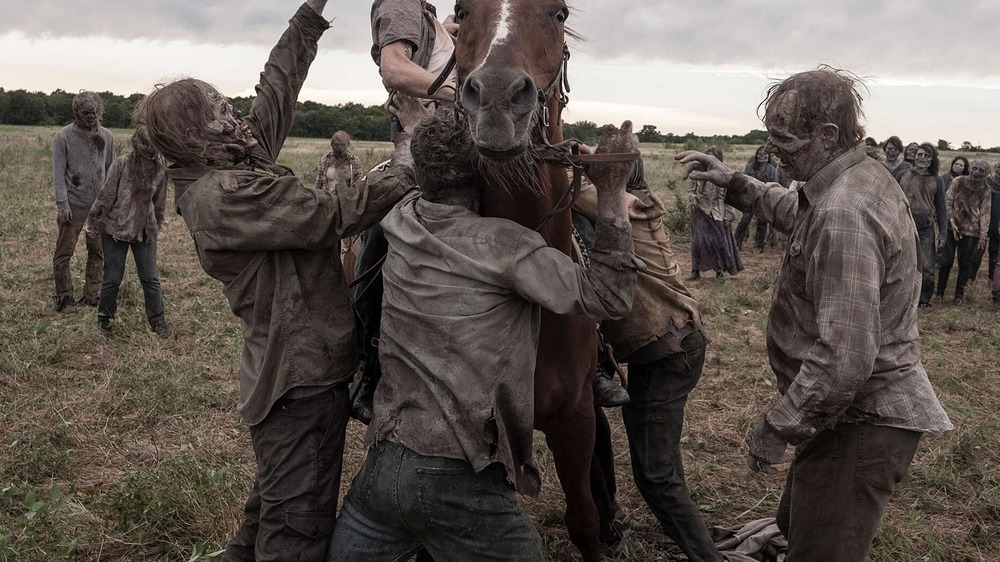The Untold Truth Of The Walking Dead's Walkers
The Walking Dead has reliably been AMC's undead cash cow for around ten years. Premiering in October 2010, the show foretelling a zombie takeover and the subsequent apocalypse quickly found a massive audience that peaked at 17.29 million viewers during the premiere of the show's fifth season, according to Forbes. Even though viewership has declined since then, the show remains entrenched as the network's most-watched program. And more recent seasons have become the series' best-reviewed, with season 9 and 10 both earning critics' ratings of 91% on Rotten Tomatoes.
What make this show so special? Well, while The Walking Dead's surviving humans give fans something to root for, the show's zombies — referred to as "walkers" — are what keep many fans tuning in week after week. No matter what scenario the survivors find themselves in, there's always a question of how the walkers will pose a threat and how exactly they'll appear in each episode. The walkers' ambivalence also makes them just as dangerous to villains as they are to the heroes. As a result, there's a lot to learn about these rotting, rambling monsters. From production decisions to the makeup and lore, here's the truth about the mysterious walkers in The Walking Dead.
The rules of the undead
Walkers in The Walking Dead are an ever-present threat to every character on the show, but they're not invincible. It's established early on in the series that the walkers generally adhere to classic tropes that go along with most zombie stories.
For instance, save for some walkers at the start of the series, the undead hordes usually only travel at a walking pace. There's a reason the show isn't called The Jogging Dead. Also, walkers are undead people, with their bites almost invariably causing a person's imminent death. However, there are solutions to this dilemma, such as when Herschel was able to stop himself from turning by decisively amputating a recently bitten limb.
When a person turns into a walker, they lose almost all vestiges of their former self. High-level cognition is unavailable to walkers, and while they might remember small things like how to open doors, that's about it. The walkers' driving force is an insatiable hunger for the flesh of living humans, a drive that can't be quelled unless the brain of the walker is somehow destroyed.
The origin of the walkers is unknown
One of the biggest questions that's plagued fans is how exactly the zombie pandemic originated in The Walking Dead universe. Unfortunately, neither the original comics or the television series provide concrete answers regarding the walkers' source or how the infection first took over the planet. Though he's been reluctant to disclose the virus' root cause in his works, Walking Dead author Robert Kirkman finally unveiled the genesis of the zombie apocalypse on Twitter.
According to the now-deleted Tweet, the virus started from some sort of "space spore." This explanation immediately raised a few eyebrows, and considering Kirkman's history of inserting jokes about aliens as the source of the zombie virus, that particular answer seemed a bit suspect. Though the space spore explanation caused some curiosity and even debate in the fandom, it would soon be confirmed that Kirkman was once again playing a prank on his fans. Shortly after he deleted his initial tweet confirming space spores started the zombie outbreak, Kirkman again took to Twitter explaining that he'd only been joking. So while a space-related entity may be a popular theory for the cause of The Walking Dead's zombie outbreak, there's still no concrete explanation of what exactly caused the plague.
The man who gives walkers unlife is an experienced zombie wrangler
One of the key creatives behind the show is Greg Nicotero, a long-time Hollywood veteran who has more practical experience with zombies than just about anyone in the world. Nicotero got his start working with zombies when he joined the crew of George Romero's 1985 film Day of the Dead. While there, he worked with legendary monster makeup artist Tom Savini to help create undead horrors.
Years of experience have given Nicotero innumerable opportunities to hone his craft. Soon after wrapping up work on Day of the Dead, Nicotero dipped his toes into many other iconic horror franchises. In addition to doing makeup for Evil Dead II, the future Walking Dead showrunner also did makeup for slasher franchises such as Nightmare on Elm Street, Halloween, Texas Chainsaw Massacre, The Hills Have Eyes, and Hostel, among others. But Nicotero didn't just limit himself to horror films. He also did makeup for Spy Kids, The Adventures of Sharkboy and Lavagirl 3-D, Transformers, and the Kill Bill movies.
Walkers in the first season are more intelligent
Throughout the series, the walkers in The Walking Dead are fairly consistent beings. They don't have any wants outside of flesh, and their means of finding food are limited to clumsily biting what prey they manage to stumble upon. Aside from the sheer power presented by a horde, walkers are simple creatures with no intelligence.
However, while the walkers never stray too far from being mindless, hunger-driven creatures, there are some notable examples where they display some amount of intelligence. Specifically, the walkers in season one are notably more resourceful than the walkers in later seasons. For example, Morgan's undead wife attempts to turn the doorknob to their home before mindlessly bashing at the front door. More impressively, some walkers can be seen using tools like rocks to break into buildings, demonstrating that they're capable of more advanced problem-solving skills than just running and biting victims.
So why exactly are the walkers in season one more intelligent? While the explanation is never made clear, series creator Robert Kirkman provides some insight. In a Reddit AMA, Kirkman explains that, "Fresher zombies, which there were more of in season one, can do more than older, more rotted zombies." In other words, the walkers in season one are newly minted and at their prime, whereas in later seasons, they've started to rot and lose their physical and intellectual capabilities.
Each episode uses a massive amount of blood to make the walkers terrifying
Bringing the undead to life for TV is no small feat. Between the precision given to costuming, makeup, and even production design, crafting the perfect walker is a huge undertaking. And an underappreciated element of The Walking Dead's walkers is the excessive amounts of blood used to make them all the more terrifying and realistic. Special effects designer Greg Nicotero told CBS News, "The Walking Dead probably uses up the most amount of blood that we've ever had on any show. I would say per episode, we're usually somewhere in the 20 to 30 gallons range."
But not all fake blood is created equal. Nicotero explains that the blood is made on set, and depending on the scene, varied recipes are used for different effects. "We have dark zombie blood, we have dried blood, we have coagulated blood. If you have a shirt like my shirt, which is dark, and you want to see the blood on it, it has to be brighter, otherwise it would just fade in with the color."
Nicotero even revealed a surprising ingredient in his blood concoction to get the right consistency. In an interview with Allure, Nicotero admitted using K-Y Jelly as a thickening agent for the blood. According to Nicotero, the crew "usually cleans out CVS and Rite Aid whenever we shoot."
Walkers were used by the showrunners to test different cameras
The walkers are crucial to the worldbuilding in The Walking Dead, meaning that special attention is given to the makeup and design of the show's undead antagonists. However, alongside the costuming and makeup department, the show's entire production is primarily centered around the question of "what makes the walkers look best onscreen?"
In an interview with Digital Trends, Greg Nicotero noted that The Walking Dead was initially conceptualized in various shooting formats. During the production of the first season, the series was tested using Panavision, a RED digital camera, and even 35 mm film before the showrunners ultimately settled on the Super 16 format. And according to Nicotero, a test shoot with a walker was a primary component that helped the production crew solidify their decision to utilize Super 16.
During the test using Panavision, a walker was placed under green trees, resulting in the walker's makeup looking green. Though color correction could be used to solve the issue, Nicotero and The Walking Dead production team decided to use Super 16, the medium that would result in the best-looking shot before color correction and editing.
The special effects have gotten more complex over time
For each episode of The Walking Dead, the necessity of special effects is a given. There's likely to be some effects work on the background of shots to make a given shooting location look different. There are also a few enhancements to characters that are likely made, such as airbrushing blemishes, enhancing sweat, or giving bloody, oozing wounds more oomph. Any scene with a walker getting stabbed with a weapon will have a prop extended to go through the shambling corpse. According to a 2012 article from LightWave, the turnaround for the show's less effects-heavy episodes was one or two weeks.
However, sometimes a third extra week was required to get each detail right for the bigger set pieces. At least this was true of the show and its more extensive sequences in 2012. But with the newer seasons, does this still hold true? According to a 2019 video from The Walking Dead's visual effects team, the old timeline doesn't cut it for the new suite of effects featured in the more recent episodes. Setting the record straight, writer/showrunner/executive producer Angela Kang said, "From the start of an episode getting locked, so this is when picture is done, through the end of the VFX process — it's a weeks-long process — on the short end, like a month. But really you want, ideally, at least a couple months to do it."
The crew has to take special care of their walker actors in extreme Georgia weather
Because The Walking Dead is filmed in Georgia, the actors, crew, and all of the extras are subjected to the at-times extreme environment. According to The Weather Channel, temperatures in the summer can reach well into the 90s, with humidity making everything feel hotter. During the colder months, temperatures on the set can sink below freezing. These intense filming conditions have created several complications for the special effects masters of the show. According to makeup artist Toby Sells, traditional materials used in climate-controlled sound stages, such as gelatin, melt in the summer sun.
Some of the workarounds used to keep extras and actors more comfortable are pretty creative. For example, David Morrisey — who played the Governor in the show's third and fourth seasons — had ice packs sewn into his leather jacket. But nevertheless, keeping everyone cool and safe is always a challenge. As costume designer Eulyn Womble explained, during the hotter days of filming, "Fighting the humidity is the hardest part. We have to keep the zombies hydrated. We have a medic on staff. If you see somebody who looks dehydrated, you do whatever you have to do to keep them comfortable."
So what happens when the temperatures drop? According to Womble, "In winter, we can layer the zombies properly, and we have a Snuggie wrangler. He literally runs out and puts Snuggies on the zombies when it's cold."
There's a limit to the decomposition of the walkers
With each new season, the walkers become more noticeably more decomposed than the ones in the last. As the apocalypse rages on, it's only natural that the undead would continually fester away as time rages onward. However, Greg Nicotero has expressed that while the walkers may become more visibly decayed, there's a line in the sand that the visual effects and makeup teams are unwilling to cross.
Though The Walking Dead has been more inclined to show sagging skin and rotting flesh in newer seasons, the walkers will never decompose to the point of becoming walking skeletons. In an interview with SlashFilm, Nicotero stated that, "[Showrunner] Scott [M. Gimple] has one very specific thing that he is conscious of, which is that it can't be a Ray Harryhausen. It can't be a walking skeleton. It always has to be muscles. It always has to be something that is motivating the movement."
So while the walkers may grow more ragged over time, Walking Dead fans can rest assured that they'll never wind up watching a modern-day version of Jason and the Argonauts. Instead, they'll get to appreciate all the new ways that walkers will decompose within the show's self-imposed limit.
Zombie fiction doesn't exist in The Walking Dead universe
The most commonly associated word with undead people walking around is "zombie." However, the term is notably absent from The Walking Dead. Shedding some light on this discrepancy in a conversation with Conan O'Brien, Robert Kirkman explained why the characters never say "zombie" in The Walking Dead.
According to Kirkman, zombie fiction simply doesn't exist. Kirkman explains, "We wanted to avoid that notion of, 'Hey, why doesn't that character just shooting that zombie in the head because it saw all those movies I saw.'" As such, the works of George Romero, the creator of the Living Dead films that established many tropes in the modern zombie genre, are absent from The Walking Dead's world.
Kirkman further explains that without Romero's works, the people within this fictional realm have no conceptualization of conventions and rules outlined in zombie media. He states that, "It felt like having people not use that word would kind of separate it from that, make it a little bit more clear." Though the word zombie is never uttered in the fictional universe, the walkers still clearly follow zombie genre conventions expected of zombie media. So while Romero doesn't exist in The Walking Dead, his influence is still pervasive.
There's a practical reason all of the walkers are so skinny
There have always been a few particularities from season to season that make The Walking Dead seem a bit far-fetched. For example, as the main cast treks through the United States, they seem to regularly be in short supply of firearm ammunition. But according to the Brookings Institute, over 400 million guns are in the United States, likely with ammunition in vast quantities, as well. Additionally, the show's survivors are frequently shown driving years after the start of the apocalypse, despite regular gasoline degrading in less than a year, according to J.D. Power.
However, there's been an even more persistent trend that seems to run counter to what one may expect in a real-life zombie apocalypse situation. In The Walking Dead, almost all of the walkers are skinny people. But when looking at the Centers for Disease Control and Prevention data for Georgia in 2019, the prevalence of self-reported obesity was 33.1%.
Given this disparity between real-life demographics and the population of the undead, series creator Robert Kirkman offered an answer. In a letter column for The Walking Dead #111, he wrote, "Frankly, it's hard to ADD to big people to make them look like zombies. Keep in mind, to make those walkers look real, you have to build stuff, on top of real people ... you start adding to people my size, and well ... we start to look a bit too padded, if that makes sense."
Walkers have a wide variety of labels
When the unthinkable happens and the dead rise to feast on the flesh of the living, a unique problem arises for those trying to eke out a life in the face of it all. What do you call your neighbor whose newest hobby is eternally milling about and trying to bite you? As demonstrated by the characters in The Walking Dead, there are many names devoted to the undead.
Rick and his initial band of survivors always use the word "walker" to refer to each undead specimen. Even though there are certainly some walkers without legs who can't live up to the moniker, it stuck anyway. But to the denizens of Alexandria, the walking corpses are called "roamers," which, due to walkers that are immobilized by injury, the elements, and the like, also doesn't quite match up with what their name implies.
Some of the more accurate names that have popped up during the show have been "rotters," as heard in season five, and "biters," as they're called by the residents of Woodbury in season three. And of course, there's also "stinker," the nomenclature used by Connie, Kelly, Luke, Magna, and Yumiko in seasons nine and ten.
